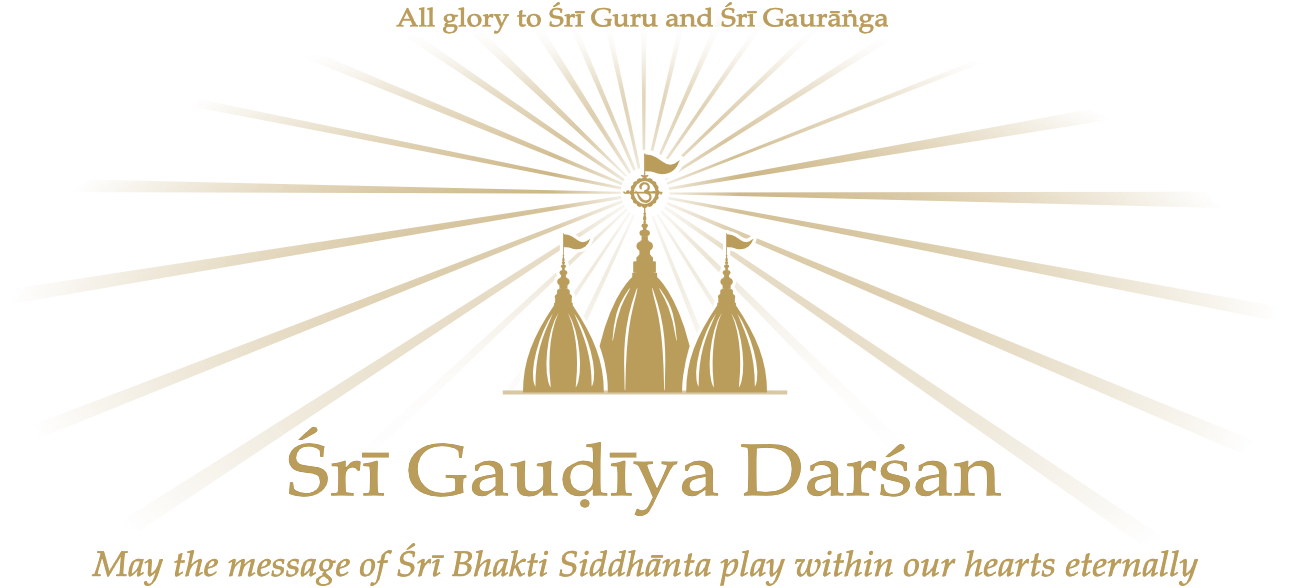Śrīla Bhakti Rakṣak Śrīdhar Dev-Goswāmī Mahārāj comments on Kṛṣṇa’s position as the Absolute Truth.
Student: There was a verse you mentioned yesterday that Śrīla Bhakti Siddhānta Saraswatī Ṭhākur used to explain satya.
Śrīla Śrīdhar Mahārāj: Yes.
satya-vrataṁ satya-paraṁ trisatyaṁ
satyasya yoniṁ nihitañ cha satye
satyasya satyam ṛta-satya-netraṁ
satyātmakaṁ tvāṁ śaraṇaṁ prapannāḥ
(Śrīmad Bhāgavatam: 10.2.26)
This verse is from the Garbha-stava in the daśam skandha [10th canto] of the Bhāgavat. It was spoken when Brahmā and the other gods chanted hymns in praise of Kṛṣṇa just before His appearance. It was their first verse. What do you ask about it?
Student: Yesterday, you were explaining that there are some persons who are worshipers of satya.
Śrīla Śrīdhar Mahārāj: There is a particular section found in Gayā of that type. They are not very particular about their creed. So, they invited our Guru Mahārāj to their place. What is the true conception of satya? Satya is the basis. So, we have to know much more about the proper conception of satya, truth. What is truth?
First of all, the truth is personal, the truth is an autocrat, and the truth is absolute good. These things to be added to understand the real nature of truth.
vedyaṁ vāstavam atra vastu śivadaṁ
(Śrīmad Bhāgavatam: 1.1.2)
Satya means vāstava-vastu: reality, truth. Vastu, substance, or existence, is of two kinds: vāstava, real, and avāstava, unreal, that is, māyic, misconception. A misconception is a finite aspect of the truth, though it is also part of the truth. Māyā is also nitya [eternal]. Vāstava-vastu [absolute truth] contains both conditioned and unconditioned existence. According to Hegel, the Absolute contains both the conditioned and unconditioned. The finite and the infinite combined is the Absolute. The infinite in itself is not sufficient. There will also be finite in relativity to it.
Student: What does ṛta-satya-netram mean?
Śrīla Śrīdhar Mahārāj: Ṛta and satya are two kinds of truth. According to me, ṛta means that which can be deduced from the truth. Ṛt dhātu [the verbal root ṛt] means gaman. So, ṛta means gata. In geometry, when data is there, then with a theorem, there can be deduction. A different conception of truth that can be deduced from data, from basic truth, is also truth. That which can be deduced from a basic truth is also true. So, ṛta is a particular kind of satya: that which we can reach or which can be produced from basic truth.
Ṛta-satya-netram means that the Lord has two eyes: satya and ṛta. It also means that He is seen through ṛta and satya; He comes into our contact through these two processes: consideration of the finite and the infinite, deduced truth and fundamental truth. Fundamental truth is there, and what He creates with that, the different varieties created by Him, are also truth. Anything created by truth or constructed in truth, differentiated characteristics over the fundamental base, vilāsa, is also truth. I like to say that ṛta is what is deduced from satya, the structure which we find on the foundation of truth, sat-chit-ānanda vilāsa.
Student: Netra here means observing?
Śrīla Śrīdhar Mahārāj: Netra means the instrument, the process by which we observe, by which we come to have a conception and understanding of a thing. Netra means a particular instrument through which we can come in contact with the outside world.
Ṛk, as in Ṛg-veda, means sound. Vede paśyanti paṇḍitāḥ [“The wise see through the Vedas”]. Our vision and destination will be through Veda, the revealed truth. Ṛta-satya-netram then can mean one who can be seen or one who sees through these two eyes: one Veda, śāstra [scripture], and the other direct perception, the sādhu. Sādhu and śāstra, who can be approached and seen by these two eyes, or who sees through these two eyes, is ṛta-satya-netram. Satya means sat, the sādhu. We can see Him through the sādhu, and we can see Him through ṛta, meaning ṛk, śāstra, Veda. Sādhu and scripture, these are the two ways by which He can be seen. We can approach Him through scripture as well as through the sādhu. So, He is known as ṛta-satya-netram.
mahājano yena gataḥ sa panthāḥ
(Mahābhārata: Vana-parva, 313.117)
The real conception in the heart of the sādhu, that is the fundamental conception of the truth, and what has been produced by the sādhus as śāstra, through that also we can see Him. So, through the practices of the sādhu (sādhu-ācharaṇ) and the advice of the scripture (śāstra-upadeś), He can be seen. This may be another interpretation.
Ṛta-satya-netram may also mean that He has two eyes, one of justice, and one of mercy. He sees us not only with an attitude of justice, but also through His other eye, that of mercy. Ṛta can mean that which can attract mercy, that which is deduced from the fundamental truth and can attract mercy; the deduction that can produce mercy in Him. So, He sees with the eye of affection and the eye of justice. According to the circumstances, He may have to distribute justice, but that is not vindictiveness; it done with mercy. So, He is ṛta-satya-netram. He sees everything with justice and affection, mercy. Satya can mean impartial estimation, equity and good sense, justice, and ṛta can mean mercy. He sees things in two ways: impartially and practically, theoretically and practically. This also may be a good interpretation.
Satyasya satyam means He who is the foundation of truth, and nihitañ cha satye means He whose basis is truth. On one side, He is the support of truth, and on the other, He is standing and playing on truth. Satya cannot stand without Him, and He has also taken His stand on satya. He is both the cause of the truth and the effect of the truth. Nihita means āhita, placed. He is placed on truth; He has accepted satya as His āsan [seat], as the plane where He is standing and playing. He is moving with the truth as the ground of His play.
Satya-vratam: what He says, He keeps; He keeps His vow of truth. Satya-param: He is above truth. Trisatyam: He is truth in the three ages, the past, present, and future; He is truth within the three guṇas (satya, rajas, and tamas); and He is truth within the three lokas: the mundane world, the spiritual world, and the taṭastha loka [marginal plane]. Everywhere, He is true, in all divisions of deśa, kāla, and pātra [place, time, and circumstance]. Amongst, His nitya-pārṣadas [eternal associates], the nitya-baddhas [conditioned souls], and the mumukṣus [seekers of liberation], everywhere He is available and true for all.
Satyasya yoniṁ: He is said even to be the cause of satya. Satya is springs up from Him.
Satyasya satyam: He is the very gist of truth, the very life of truth. He is sārasya sāram: the truth of the truth, the very essence of the truth.
Reference
Spoken 31 August 1981.



Leave a Reply